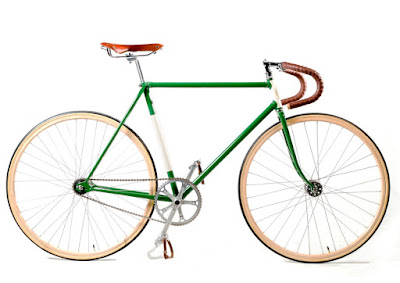This has been one of the warmest winters on record. (It seems that we've been hearing that every other year for the past twenty or so!) So, not surprisingly, we're having a warm St. Patrick's Day. The last time I checked, the temperature had risen to 13C (65F) and was predicted to go higher.
There is a "possibility" of rain, according to the forecast. Still, I think I'm going for a ride, however brief, after work.
What does one wear on a St. Patrick's Day ride? This, perhaps?:
You can get that jersey from AeroTech Designs. Maybe you'll wear it on next year's St. Patrick's Day ride, along with this cap:
Then again, if you're like me, you don't buy cycling-specific clothing. Maybe you'll get decked out like one of these folks:
Since the weather is warm (at least in this part of the world), perhaps something like this is in order:
or if you are in one of those places where this day's weather reminds you that Spring hasn't officially arrived yet, you might think of this:
or this:
Maybe you like to ride in tweed, or something that looks like it:
Then there is the question of what to ride. This certainly is lovely:
and, really, no less practical than this:
As for me, I'll probably do my St. Patrick's Day ride on this:
All right. So the bike is English. So are most of the bikes that have ever been ridden in Ireland. So, for that matter was St. Paddy himself.
And how many of you are drinking Bass ale* today?
*=I'm not referring to Budweiser beer sold under the Bass name.
There is a "possibility" of rain, according to the forecast. Still, I think I'm going for a ride, however brief, after work.
What does one wear on a St. Patrick's Day ride? This, perhaps?:
You can get that jersey from AeroTech Designs. Maybe you'll wear it on next year's St. Patrick's Day ride, along with this cap:
Then again, if you're like me, you don't buy cycling-specific clothing. Maybe you'll get decked out like one of these folks:
Since the weather is warm (at least in this part of the world), perhaps something like this is in order:
 |
| From Eleanor's |
or if you are in one of those places where this day's weather reminds you that Spring hasn't officially arrived yet, you might think of this:
 |
| From Eleanor's |
or this:
 |
| From LJ World |
Maybe you like to ride in tweed, or something that looks like it:
 |
| From Meetzorp |
Then there is the question of what to ride. This certainly is lovely:
 |
| Freddie Grubb track bike. Photos from Megadeluxe |
and, really, no less practical than this:
 |
| 1953 Schwinn Debutante. Photo from Meetzorp |
As for me, I'll probably do my St. Patrick's Day ride on this:
All right. So the bike is English. So are most of the bikes that have ever been ridden in Ireland. So, for that matter was St. Paddy himself.
And how many of you are drinking Bass ale* today?
*=I'm not referring to Budweiser beer sold under the Bass name.






